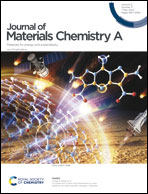Low-hysteresis and highly linear sensors based on environmentally stable, adhesive, and antibacterial hydrogels†
Abstract
Flexible strain sensors have attracted great attention in the fields of human motion detection and wearable electronics. However, it is still a great challenge to integrate environmental stability, adhesion, and antibacterial properties into one hydrogel sensor while ensuring an accurate output signal. To address this challenge, a series of multifunction ionic hydrogels (PVA-PA-E/M hydrogels) was prepared. These hydrogels displayed a double network structure, with phytic acid (PA) crosslinking poly(vinyl alcohol) (PVA) as the first network and polymers containing ethyl acrylate (EA) and 3-(methylacrylamide) propyl trimethylammonium chloride (MPTC) as the second network. They not only demonstrated high adhesive strength (up to 71.0 kPa), excellent antibacterial properties (reaching 100% efficiency), and high conductivity (up to 9.1 S m−1) simultaneously, but were also capable of constructing strain sensors with low electrical hysteresis of 0.0356 and high linearity (R2 = 0.999) at a strain range of 0 to 300%. The hydrogel-based strain sensors performed well in detecting human motion, such as joint bending, running, speaking, and information transmission. Moreover, the adhesion and sensing performance of the sensors remained stable in various potential application scenarios, including high and subzero temperatures, long-term storage, and water environments. This work is expected to pave the way for the design of high-performance flexible strain sensors with multifunction and favorable environmental adaptability.



 Please wait while we load your content...
Please wait while we load your content...